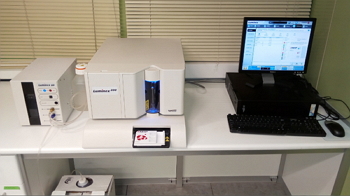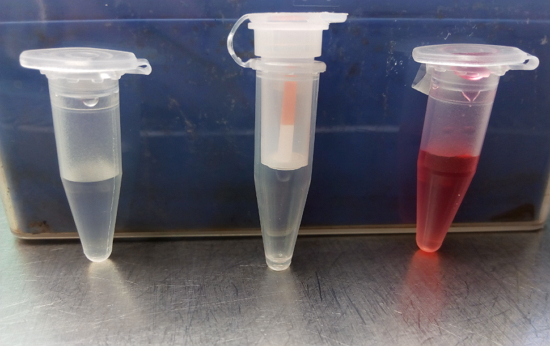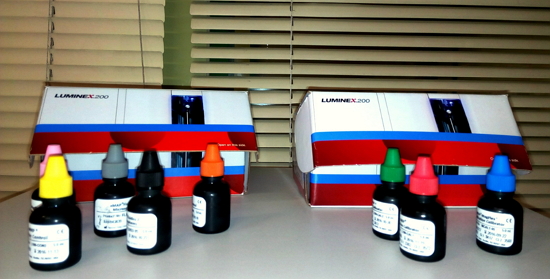DIAGNOSIS OF PERIODONTAL INFECTIONS USING INMUNOCHEMICAL ASSAYS, ELISA AND LUMINEX
|
Description |
Study of biochemical markers related to dental diseases. The ELISA (enzyme-linked immunosorbent assay) allows the antigen or antibody identification in different kinds of samples like saliva, gingival crevicular fluid or blood, in order to determinate the immunological state of the individuals and therefore to study the stage of the development of the disease. This technology allows studying one analytic in each assay, hence it is very useful when the number of parameters that are going to be studied is not high. If a larger study is required it is possible to use Luminex technique. The Luminex® 100/200™ is a flexible analyser based on the principles of flow cytometry that allows the simultaneous analysis of 100 different analytics in the same sample volume. This technique also enables to perform bioassays, but not only immunochemical ones but also enzyme assays of receptor to ligand and nucleic acid tests.
ELISA and Luminex are widely used in studies in the field of biology, biochemistry and medicine. These two techniques have also shown its importance in the area of dentistry by being essential in the studies of the type of immune response triggered by different bacterial infections and in understanding of the mechanisms involved in bone remodelling processes.

The equipment consists of a Luminex technology analyzer based on flow cytometry and software XPONENT
|
How does it work |
The ELISA assay is based on the use of antigens or antibodies labelled with an enzyme, making the resulting conjugates have both immunological and enzymatic activity. Due to the fact that one of the components (antigen or antibody) is labelled with an enzyme and insolubilized on a support (immunoadsorbent) the antigen-antibody reaction will be immobilized and therefore it will be easily revealed by adding a specific substrate, after the reaction the enzyme will produce a color observable or measurable with spectrophotometer or colorimeter.

Samples taken from patients for analysis by immunoassay techniques. Left to right: saliva sample, sample taken with Periopaper, plasma sample.
In the Luminex 100/200 ™ technique the reagents (antibodies, oligonucleotides, substrates, etc.) are anchored to the surface of polystyrene microspheres. The emission spectrum of each of these microspheres is unique, and allows simultaneous identification of all of them and therefore the reaction or test being carried out on each surface. The microspheres are labelled with two fluorophores in a way that a ratio of each one of them is established in each microsphere. Thus the first of the microspheres appears with 100% of the first fluorophore and 0% of the second one, the 2nd microsphere with 99% of the first fluorophore and 1% of the second one and so on until 100 microspheres are perfectly identifiable within the reaction tube. After the different incubations, where flourophores will attach to the specific reagents of the assays (antibodies, oligonucleotides, substrates, etc.), anchored on the surface of the spheres, the plate in which the test is performed will be read in the Luminex system 100/200 ™ where the microspheres pass through the stream flow.
In the Luminex 100/200 ™ technique the reagents (antibodies, oligonucleotides, substrates, etc.) are anchored to the surface of polystyrene microspheres. The emission spectrum of each of these microspheres is unique, and allows simultaneous identification of all of them and therefore the reaction or test being carried out on each surface. The microspheres are labelled with two fluorophores in a way that a ratio of each one of them is established in each microsphere. Thus the first of the microspheres appears with 100% of the first fluorophore and 0% of the second one, the 2nd microsphere with 99% of the first fluorophore and 1% of the second one and so on until 100 microspheres are perfectly identifiable within the reaction tube. After the different incubations, where flourophores will attach to the specific reagents of the assays (antibodies, oligonucleotides, substrates, etc.), anchored on the surface of the spheres, the plate in which the test is performed will be read in the Luminex system 100/200 ™ where the microspheres pass through the stream flow.
Sampling:
Samples of gingival crevicular fluid are usually collected using a Periopaper, which will remain around 30 seconds into the gingival sulcus facilitating sampling by capillarity. The blood stained samples must be discarded as it can cause interferences in the development of immunoassay. Once collected, they must be stored at -80 ° C until subsequent analysis. A special buffer is used for sample extraction from the Periopaper prior to performing the analysis.
If samples to be studied are of saliva, its secretion should be stimulated and collected in vials of variable capacity depending on the study. These samples will be centrifuged and the precipitated portion will be preserved at -80 ° C until analysis by selected immunoassay technique.
Blood samples are usually collected in the special tubes, depending on the parameters that are to be studied. These vials will be centrifuged to collect plasma or serum, and will be frozen at -80 ° C until analysis. Sample Freezing allows its accumulation to be analyzed at the same time, favoring the study under the same experimental conditions.
|
Advantages |

Analyses with Luminex require a high degree of control in terms of equipment calibration and verification ensuring the accuracy of measurements.
These high precision techniques can be useful in the diagnosis and treatment of periodontitis and related systemic diseases. Among the benefits of using these techniques can be highlighted:
- Sample Volume. If high sample volumes are taken, either of the two techniques could be valid. If the sample volume is limited, such as cerebrospinal fluid samples, gingival crevicular fluid, synovial fluid, tears, mouse serum, etc., the Luminex 100/200 ™ system allows the analysis of various parameters using a very small sample volume.
- Analysis Duration: The total time is the same for both techniques if one parameter is analyzed. If you want to analyze several parameters the Luminex system saves lot of time as it analyzes all at the same time.
|
Where has it been developed |
These techniques have been developed in the Section of Periodontology, Stomatology III Department of Dental Faculty. Research laboratory participates in projects related to the study of immunological markers with satisfactory results. It also represents a useful tool for the diagnosis and treatment of patients attended in the Master of Periodontology of the same Faculty. Technical assistance of highly qualified personnel as well as consulting in the analysis of the results, is provided to researchers.
|
And also |
With these technologies can provide assistance in research and in clinical dentistry in several ways:
- Add the analysis of immunological variables in research within the field of dentistry.
- Assist in the diagnosis and treatment of the patients by analysing their immune response.
- Assist in the investigation of bone remodelling mechanisms involved in the development of periodontitis through studies "in vitro".
- Assist in the investigation of other systemic diseases related to the development of oral pathologies.
|
Contact |
|
© Office for the Transfer of Research Results – UCM |
|
PDF Downloads |
|
Classification |
|
Responsible Researcher |
Mariano Sanz Alonso: marianosanz@odon.ucm.es
Department: Stomatology III
Faculty: Dentistry


